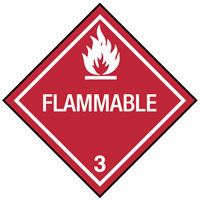
 Print
Print
Chemical Datasheet
METHYL ISOPROPENYL KETONE, STABILIZED |

|
Chemical Identifiers
| CAS Number |
UN/NA Number |
DOT Hazard Label |
USCG CHRIS Code |
- 814-78-8

|
|
|
|
| NIOSH Pocket Guide |
International Chem Safety Card |
|
none
|
none
|
NFPA 704
General Description
A clear colorless liquid. Flash point of 52°F. Denser than water and insoluble in water. Hence sinks in water. Vapors heavier than air.
Hazards
Reactivity Alerts
- Highly Flammable
- Polymerizable
Air & Water Reactions
Highly flammable. Insoluble in water.
Fire Hazard
Behavior in Fire: May polymerize and explode. (USCG, 1999)
Health Hazard
Inhalation causes irritation of nose and throat. Liquid may cause severe damage to eyes, resulting possibly in some permanent impairment of vision; vapor produces tears. If not removed promptly from skin, liquid may cause delayed pain and blistering. Ingestion causes irritation of mouth and stomach. (USCG, 1999)
Reactivity Profile
METHYL ISOPROPENYL KETONE tends to polymerize; this reaction is mostly suppressed by the inhibitor. Can polymerize if heated or contaminated. If confined in a container when polymerization is initiated, the container may violently rupture (USCG, 1999).
Belongs to the Following Reactive Group(s)
- Ketones
- Hydrocarbons, Aliphatic Unsaturated
- Polymerizable Compounds
Potentially Incompatible Absorbents
Use caution: Liquids with this reactive group classification have been
known to react with the
absorbents
listed below.
- Mineral-Based & Clay-Based Absorbents
- Dirt/Earth
Response Recommendations
Isolation and Evacuation
Excerpt from ERG Guide 127

[Flammable Liquids (Water-Miscible); polymerization hazard]:
IMMEDIATE PRECAUTIONARY MEASURE: Isolate spill or leak area for at least 50 meters (150 feet) in all directions.
LARGE SPILL: Consider initial downwind evacuation for at least 300 meters (1000 feet).
FIRE: If tank, rail tank car or highway tank is involved in a fire, ISOLATE for 800 meters (1/2 mile) in all directions; also, consider initial evacuation for 800 meters (1/2 mile) in all directions. (ERG, 2024)
Firefighting
Excerpt from ERG Guide 127

[Flammable Liquids (Water-Miscible); polymerization hazard]:
CAUTION: The majority of these products have a very low flash point. Use of water spray when fighting fire may be inefficient. CAUTION: For fire involving UN1170, UN1987 or UN3475, alcohol-resistant foam should be used. CAUTION: Ethanol (UN1170) can burn with an invisible flame. Use an alternate method of detection (thermal camera, broom handle, etc.).
SMALL FIRE: Dry chemical, CO2, water spray or alcohol-resistant foam.
LARGE FIRE: Water spray, fog or alcohol-resistant foam. Avoid aiming straight or solid streams directly onto the product. If it can be done safely, move undamaged containers away from the area around the fire.
FIRE INVOLVING TANKS, RAIL TANK CARS OR HIGHWAY TANKS: Fight fire from maximum distance or use unmanned master stream devices or monitor nozzles. Cool containers with flooding quantities of water until well after fire is out. Withdraw immediately in case of rising sound from venting safety devices or discoloration of tank. ALWAYS stay away from tanks in direct contact with flames. For massive fire, use unmanned master stream devices or monitor nozzles; if this is impossible, withdraw from area and let fire burn. (ERG, 2024)
Non-Fire Response
Excerpt from ERG Guide 127

[Flammable Liquids (Water-Miscible); polymerization hazard]:
ELIMINATE all ignition sources (no smoking, flares, sparks or flames) from immediate area. All equipment used when handling the product must be grounded. Do not touch or walk through spilled material. Stop leak if you can do it without risk. Prevent entry into waterways, sewers, basements or confined areas. A vapor-suppressing foam may be used to reduce vapors. Absorb or cover with dry earth, sand or other non-combustible material and transfer to containers. Use clean, non-sparking tools to collect absorbed material.
LARGE SPILL: Dike far ahead of liquid spill for later disposal. Water spray may reduce vapor, but may not prevent ignition in closed spaces. (ERG, 2024)
Protective Clothing
Goggles or face shield; rubber gloves. (USCG, 1999)
DuPont Tychem® Suit Fabrics
No information available.
First Aid
INHALATION: remove victim from exposure; give artificial respiration if needed; call physician.
EYES: immediately irrigate with copious amounts of water for 15 min.; call physician.
SKIN: wash off skin with large volumes of water for 15 min.; call physician if burn has occurred.
INGESTION: induce vomiting; call physician. (USCG, 1999)
Physical Properties
Flash Point:
less than 73°F
(USCG, 1999)
Lower Explosive Limit (LEL):
1.8 %
(USCG, 1999)
Upper Explosive Limit (UEL):
9 %
(USCG, 1999)
Autoignition Temperature: data unavailable
Melting Point:
-65°F
(USCG, 1999)
Vapor Pressure: data unavailable
Vapor Density (Relative to Air): data unavailable
Specific Gravity:
0.85
at 68°F
(USCG, 1999)
- Less dense than water; will float
Boiling Point:
208°F
at 760 mmHg
(USCG, 1999)
Molecular Weight:
84.1
(USCG, 1999)
Water Solubility: data unavailable
Ionization Energy/Potential: data unavailable
IDLH: data unavailable
AEGLs (Acute Exposure Guideline Levels)
No AEGL information available.
ERPGs (Emergency Response Planning Guidelines)
No ERPG information available.
PACs (Protective Action Criteria)
No PAC information available.
Regulatory Information
EPA Consolidated List of Lists
No regulatory information available.
CISA Chemical Facility Anti-Terrorism Standards (CFATS)
No regulatory information available.
OSHA Process Safety Management (PSM) Standard List
No regulatory information available.
Alternate Chemical Names
- ISOPROPENYL METHYL KETONE
- METHYL ISOPROPENYL KETONE
- METHYL ISOPROPENYL KETONE, STABILIZED
- METHYL ISOPROPENYL KETONE, [STABILIZED]
- 2-METHYL-1-BUTENE-3-ONE
- 3-METHYL-3-BUTEN-2-ONE
- 3-METHYLENE-2-BUTANONE
- PROPEN-2-YL METHYL KETONE


 Print
Print
